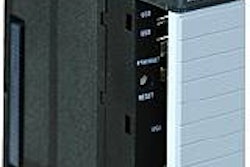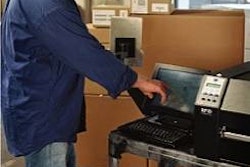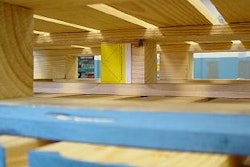![1-Intermec's IP3 Intellitag[r] portable unit can read up to 6 tags/sec.](https://img.packworld.com/files/base/pmmi/all/image/2011/09/pw_11473_3_nl_rf_rl_mobile1_intrmec.png?auto=format%2Ccompress&q=70&w=400)
If you have fixed your data collection plans solely on RFID reader-antennae portals, then you may want to recalibrate your strategy a bit. Vendors offer wireless mobile solutions that permit flexible alternatives to fixed portals for RFID data acquisition. The value of such a solution for consumer packaged goods companies (CPGs) depends on your company’s specific needs.
Thomas Ryan, principal, TKR Consulting Associates, sees fixed RFID portals’ role as that of capturing RFID information for goods going into and out of the warehouse. But for tracking flow within warehouses and distribution centers, portable devices have their place, he says.
“Handheld and lift truck-mounted devices can augment existing bar-code scanners as a part of the RF terminal network for goods within the warehouse,” notes Ryan.
Natural progression
Ralf Saykiewicz, formerly an RFID expert with Deloitte Consulting, recently joined Chicago-based Technology Solutions Co. as vice president, solutions and architecture. He believes that mobility is a natural part of data gathering via RFID. “It is in tune with the overall philosophy of mobile business devices such as PDAs, laptops, and cellular phones,” he says. “The market for mobile RFID devices is growing rapidly. This comes not only from traditional users, but also from the U.S. Department of Defense, which is currently seeking appropriate mobile UHF devices for a blanket purchasing agreement. That means a high demand for many thousands of these devices in a short time.”
Will these mobile solutions replace or augment fixed readers and antennas?
“Fixed RFID hardware plays a very important role in generating data in the business mode, and is currently more reliable than handheld units,” says Saykiewicz. “Fixed devices have a greater read range and play into the 0HIO principle—Zero Human Intervention Operation. Fixed devices are affixed at one choke point and are automatically activated once any object—RFID enabled or not—passes through its read range.
“This usually is enabled by a photocell synchronized with the particular fixed reader. This event does not require the intervention of an operator. It accelerates processes and makes them more reliable. Handheld devices supplement the process and are a source of additional data, but due to the human factor involved, should not be the primary source of data collection.”
Mobile RFID advantages
“The first and foremost advantage is the mobility factor,” says Saykiewicz. “It allows gathering data at customer and retailer locations. It allows for data verification at the point of delivery and real-time data transfer using wireless technologies. In short, handheld devices can gather data where fixed readers can’t.”
Saykiewicz pointed out a specific RFID vendor that offers a handheld UHF RFID reader in form of a PCMCIA card that fits into the expansion slot of any PDA (see this and other products below).
What disadvantages?
“Mobile technology in RFID HF has been around for quite a long time, but the technology has advanced into UHF,” says Saykiewicz. “Reader size is decreasing as accuracy is increasing. However, with form factor size reduction the challenge has been shifted to battery manufacturers. A PCMCIA-sized RFID reader will eat the PDA battery in less than 30 minutes. The challenge currently is to source batteries that can support the device.”
What follows is a sampling of mobile RFID solutions. The products are keyed to the images by number, and the supplier contact information follows at the end of the article.
1-UHF RFID-reader computer
Intermec Technologies offers the IP3 Intellitag reader as an accessory to its 700 series color mobile computer. Operating at 915 MHz, the IP3 combines RFID tag read/write capability with the power of handheld mobile computing. The integrated circular antenna is capable of reading up to six tags per second; the unit retains up to 100 tags in volatile memory.
2-Mobile bar code, RFID scanner
The MX3-RFID mobile computer from LXE permits both bar-code and RFID scanning capabilities from the same unit by flipping a switch. The MX3-RFID uses the Windows CE .NET operating system. The tag reader and RFID antenna are fully protected in a very low-profile enclosure in the rear of the unit, so there is no concern about damaging fragile external RFID antennas. Simple-to-operate unit allows easy control of what’s being read by the unit's "read range" via RF power setting.
3-Integrated UHF RFID reader
Psion Teklogix has launched an EPC-compliant 900 MHz RFID reader designed to operate with the co.’s 7535 handheld computer. Reader provides customers with a cost-effective RFID option that is flexible and compatible with EPC Class 0, 0+ and Class 1 standards, and is upgradable to Gen 2 protocols. The rugged reader features an ergonomic pistol-grip design.
4-Portable interrogator
The MC9000-G RFID portable interrogator-antenna from Symbol Technologies is capable of reading EPC UHF tags at distances of up to 10 feet. The lightweight unit is designed, tested and manufactured to withstand repeated six-foot drops to concrete. It also features directional (70° forward) field generation to enable users to isolate the RFID tags they are interested in reading.
5-HF industrial handheld computer
The JETT-RFID, a rugged handheld computer from Two Technologies can read and write 13.56 MHz frequency RFID tags. It offers an MS Windows CE.NET 4.2 operating system and color touchscreen panel. The unit’s typical read range is about three inches.
6-PCMIA card connector for UHF
WJ Communications’ MPR 6000 RFID Card includes the analog RF, digital circuitry and embedded firmware required for EPC Class 0 and EPC Class 1 operation in a modular design. The card, which requires an external antenna, plugs into any PCMCIA Type II socket. It operates at UHF 902-928 Mhz at a power of 1/2-watt. A simple downloadable firmware upgrade accepts future standards like UHF Gen 2. Applications include handheld devices, printers, smart packaging, material handling, and industrial products.
























